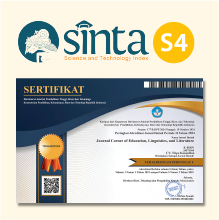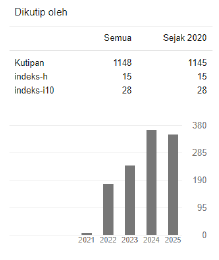Analysis of Infinitive Phrases in Novel By J.K.Rowling ‘Harry Potter and the Sorcerer’s Stone’
 https://doi.org/10.54012/jcell.v1i4.36
https://doi.org/10.54012/jcell.v1i4.36
 Abstract views: 1157
Abstract views: 1157
 PDF downloads: 511
PDF downloads: 511
Keywords:
infinitive, infinitive phrase, bare infinitive, novelAbstract
Infinitive phrase may function, not as a main verb of a clause, but as another part of speech—either as a noun, adjective, or adverb that takes the form of “to + verb” in its simplest form. This research is done to find out the types of infinitives found in the novel written by J.K. Rowling, ‘Harry Potter and the Sorcerer’s Stone’ and the function of infinitives found in the novel written by J.K. Rowling, ‘Harry Potter and the Sorcerer’s Stone’ done by 7 students of Magister of English Education of Lampung University. This study uses a qualitative descriptive approach, and the data is taken from the novel written by J.K Rowling ‘Harry Potter and the Sorcerer's Stone’ page 1-8, 33-40, 65-72, 97-104, 129-136, 161-168, and 193-200.From the results and discussion, it can be concluded that not all students look for the same forms and classification of the infinitive, but the dominant types used in the novel is the to-infinitive.
Downloads
References
Apriyanto, S., Dalman, & Santoso, D. (2020). The urgency of forensic linguistics in a police interrogation process. International Journal of Psychosocial Rehabilitation, 24(6), 4766–4772. https://doi.org/10.37200/IJPR/V24I6/PR260467
Azhar, Betty S and Hagen, Stacy A. (2009).Understanding and Using English Grammar.Fourth Edition with Answer Key.New York: Pearson Education.
Frank, Marcella. (1972). Modern English: a Practical Reference Guide. New Jersey: Practice Hall Inc.
Greenbaum S, Quirk R. (2003). A Student's Grammar of the English Language 1st Edition. United States: Hinoyama.
Gu, Wenyuan. (1984). On the Omission of the Infinitive Sign “to”, printed in the Journal of Shanghai Maritime University, No. 1, Shanghai China.
Hopps, K. L. (2013). Intersetting communication and the transition to school. Charles Sturt University.
Kholik, MujibNur. (2017). Infinitive Analysis in Fitzgerald’s The Great Gatsby Novel. Thesis, English Education Department.Tarbiyah Faculty: IAIN Ponorogo.
Krippendorff, K. (2004). Content Analysis: An Introduction to Its Methodology. In S. Margaret H (Ed.), Education (Second Edi). SAGE Publication. https://doi.org/10.2307/2288384
Levitt, H. M., Motulsky, S. L., Wertz, F. J., Morrow, S. L., &Ponterotto, J. G. (2017). Recommendations for Designing and Reviewing Qualitative Research in Psychology: Promoting Methodological Integrity. Qualitative Psychology, 4(1), 2–22.
Schatz, Mary S. (2002). Grammar Rules! For Students, Parents & Teachers, A Straightforward Approach to Basic English Grammar and Writing Skills. Oregon: Garlic press.
Strauss, A., & Corbin, J. (2008). Basics of Qualitative Research: Techniques and Procedures for Developing Grounded Theory (3rd Ed.). Thousand Oaks, London, New Delhi: SAGE Publications.
Syah, T. A., Nurhayaty, A., & Apriyanto, S. (2021). Computerized Text Analysis on Self-Description Text to Get Student’s Prevailing, Confidence, and Drives. Journal of Physics: Conference Series, 1764(1). https://doi.org/10.1088/1742-6596/1764/1/012056
Triana, Y., Sari, I. F., & Apriyanto, S. (2020). Language features and causes of suicide case from forensic linguistics point of view. International Journal of Psychosocial Rehabilitation, 24(6), 7955–7966. https://doi.org/10.37200/IJPR/V24I6/PR260803
Van Charldorp, T. C. (2014). “What happened?” From talk to text in police interrogations. Language and Communication, 36(1), 7–24. https://doi.org/10.1016/j.langcom.2014.01.002
Ward, H. W. (2015). A Comparative Analysis of Hedging in a Corpus of Two Written Legal Discourse Genres. Universidad Politécnica de Madrid.
Downloads
Published
How to Cite
Issue
Section
License
Copyright (c) 2022 Niken Wulandari

This work is licensed under a Creative Commons Attribution-ShareAlike 4.0 International License.
All articles published in the Journal Corner of Education, Linguistics, and Literature are licensed under the Creative Commons Attribution-ShareAlike License (CC BY-SA).

















